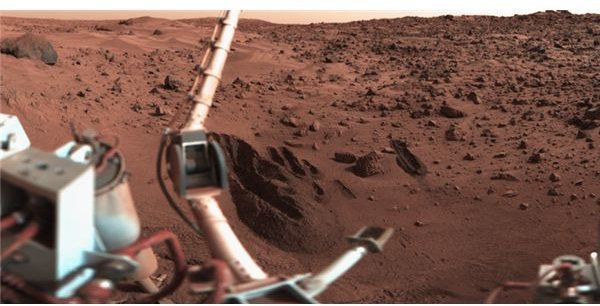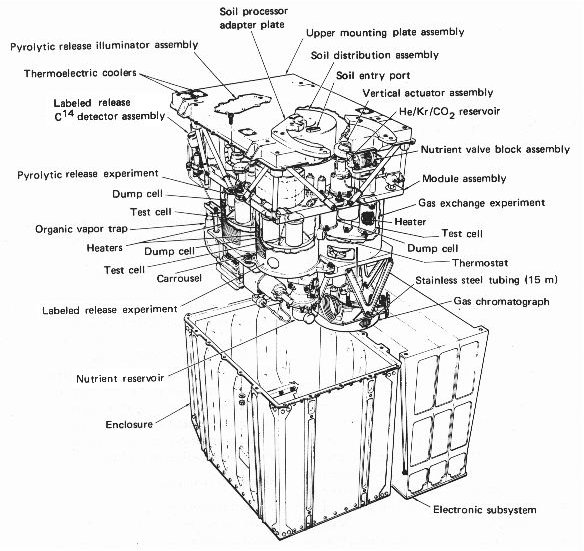Viking Mission to Mars - Experimenting on the Red Planet
Viking Mission Experiments
Viking performed four major experiments on Mars.
The first was the Gas Chromatograph – Mass Spectrometer experiment in which a device (GCMS) chemically separated vapor components of the Martian soil and read the molecular weight of each chemical in a mass spectrometer. The result showed even less carbon in the soil than was present on the moon.
The Gas Exchange (GEX) experiment replaced the Martian atmosphere in a soil sample with helium in an incubation chamber. Over time the samples were tested to measure the concentrations of the gases. This was designed to see if some form of life was metabolizing the gases.
In the third experiment, known as Labeled Release (LR), a sample of soil was given a drop of nutrient solution containing a radioactive carbon. The experiment monitored the soil to see if the carbon was metabolized. On the first attempt at this experiment, there was immediate results in the form of radioactive gases. However, each subsequent experiment proved inconclusive.
The Pyrolytic Release experiment was designed to be a test of each of the preceding experiments upon success. As none of the others were successful, this one was conducted on its own. A simulated Martian atmosphere, again with radioactive carbon, was created. A soil sample was exposed to the atmosphere, light and water with the goal of identifying photosynthetic organisms. After a period of incubation over several days, the sample was heated to remove the gases and test for radioactivity in the biomass. Again, this experiment showed no results.
Intitial Results of the Missions
Most scientists working in the field at the time were surprised by the results from the Viking missions. Namely that no organic compounds were found on the surface of the red planet. Meteorites from space had been found to contain organic compounds both prior to and after the experiments, raising questions as to why the surface of Mars was different. However, since the experiments were generally designed to identify metabolism, most in the scientific community determined the experiments to be inconclusive.
The fact that the LR experiment released an initial positive result could be best explained by the fact that the soil has a strong oxidant built up due to a lack of ozone layer on the planet. This exposes the surface to UV light form the Sun. An oxidizing molecule would react with water to produce hydrogen and oxygen and nutrients to make carbon dioxide. This theory was upheld in August 2008 when the Phoenix lander detected a strong oxidizer known as perchlorate.
Most important to the entire mission was that the GCMS experiment did not reveal any significant levels of carbon.
Above right: Viking Biological Experiment Schematic. (Supplied by NASA; Public Domain; https://upload.wikimedia.org/wikipedia/en/d/d4/Viking_Biological_package.I.png)
The Experiments Cause Debate
Over the years, new analysis of the experiments has created criticism and controversy over the proper controls used and general assumptions about the conclusions. Some of these debates come from very reputable sources, even within the Viking program itself.
An article published in the International Journal of Astrobiology in 2007 addressed concerns about the GCMS experiment. According to the investigators, the solvent used to test the organic compounds was too strong for reduction. This assumption was upheld by the National Academy of Sciences.
In the 1999 book Life on Mars: The Complete Story by Paul Chambers, the author believed that the LR experiment does indeed raise the argument for life. This feeling is shared with one of the experiment’s designers, Gilbert Levin. Similar research conducted on Earth showed very close matches to the results of the experiment.
Additional criticism about the experiments in general continue to plague the overall Viking mission. An atmospheric scientist, James Lovelock, reported in 2000 that the mission should have examined the atmosphere itself rather than the soil. Likewise the American Astronomical Society released a paper in 2007 questioning whether the landers’ exhaust itself killed off any life present at the location.
What the Future Holds for Martian Experiments

Despite the setbacks from the Viking program, Mars exploration did not end with the missions. While it was 14 years before NASA mounted another mission, it did so with great success. The Mars Pathfinder mission with its Sojourner rover landed in 1997 and opened up a new era in Mars exploration. Ultimately, its success led to to larger rovers, Spirit and Opportunity.
The search for life also did not end with Viking. In 2003, the European Space Agency attempted a lander known as Beagle 2. However, it was destroyed on landing. In 2008, NASA successfully landed the Phoenix Scout lander, which may have located water deposits. The most modern experiment, the Mars Science Laboratory, is scheduled for launch in 2011. This will perhaps answer some of the earlier questions left from the Viking missions.
Above left: Trenches Dug on Mars by the Viking Mission. (Supplied by NASA; Public Domain; https://upload.wikimedia.org/wikipedia/commons/1/1b/Mars_Viking_11d128.png)
Resources
“Viking Mission May Hold Secret to Life” ScienceDaily
“Water on Mars” Biospherics Inc.
Related Links
The Viking Mission to Mars - Landing on the Red Planet
The Next Mission to Mars - Curiosity
This post is part of the series: The Mars Exploration Rover and Past Missions
Mars exploration rover and Viking mission are highly important to our history of the red planet. The overall goal in Mars exploration rover technology and the new Mars Science Laboratory is to analyze the possibility of a manned mission to Mars and possibly find water.
